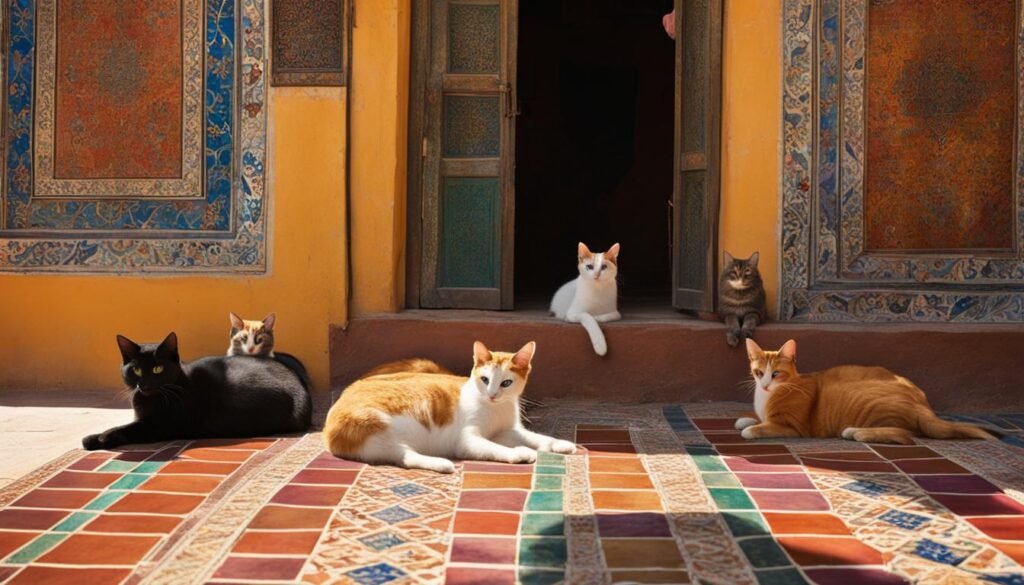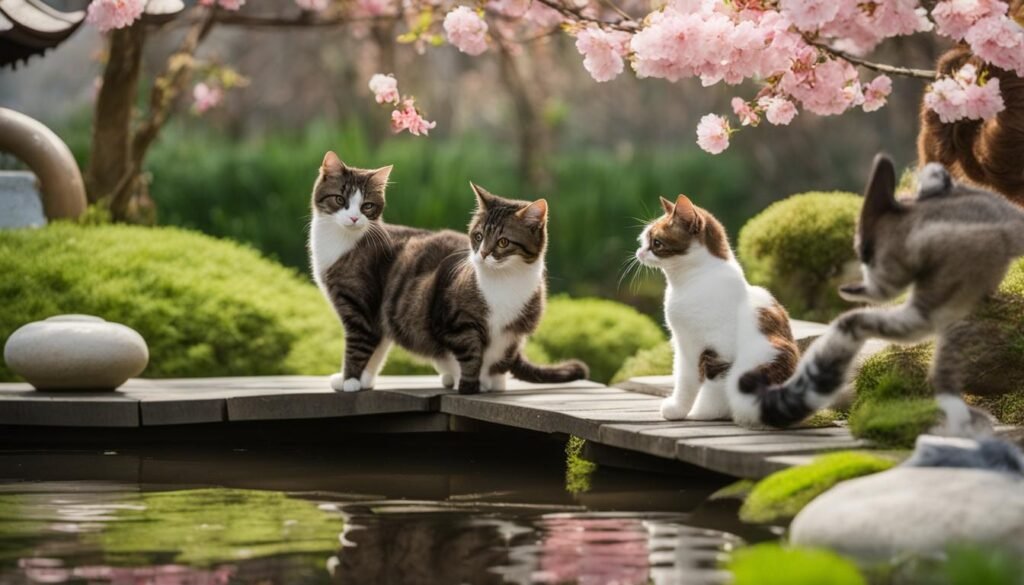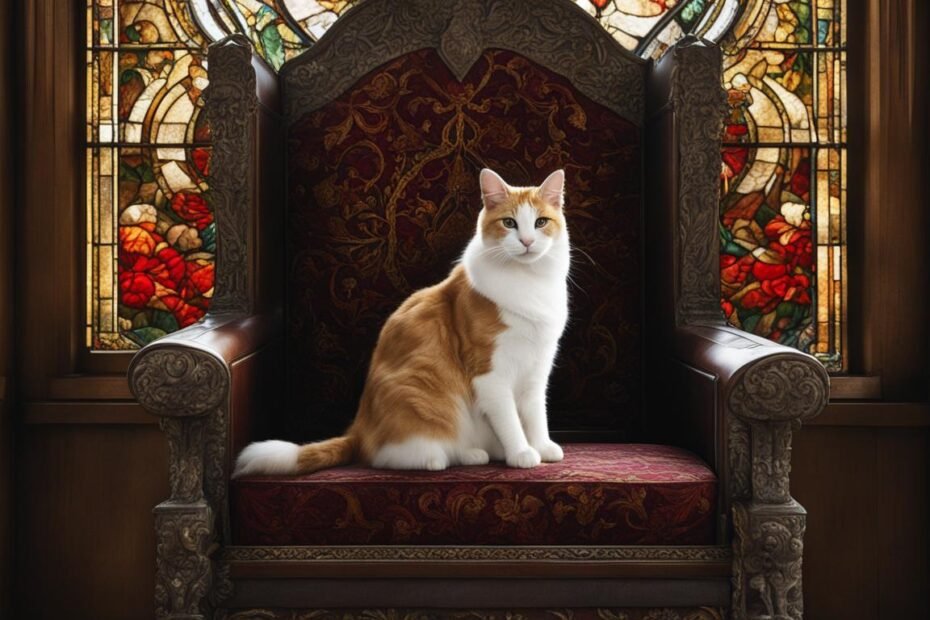People have kept domesticated felines for thousands of years, and cats have held a special place in medieval Europe. From the Islamic World to Europe and East Asia, cats played various roles in society. In the Islamic World, cats were considered ritually clean and were kept as pets at all levels of society. In Europe, cats were associated with superstitions and were sometimes persecuted during times of crisis. However, they were also valued for their hunting skills and became cherished companions in monasteries. In East Asia, cats were kept for their rodent control abilities and were viewed as good luck symbols.
Key Takeaways:
- Medieval Europe had a rich history with cats, with different roles and perceptions in different regions.
- Cats were considered ritually clean and kept as pets in the Islamic World.
- In Europe, cats were associated with superstitions and sometimes faced persecution during crises.
- In East Asia, cats were valued for their rodent control abilities and symbolized good luck.
- Cats formed deep bonds with their human counterparts, despite societal suspicions.
Cats in Medieval Europe: Unraveling the Superstitions
Cats did not have an easy life in medieval Europe. Unlike dogs, cats were often associated with evil and faced persecution during times of crisis, such as the black death. In the Flemish town of Ypres, cats were even thrown from the belfry tower during a ritualized festival.
However, not all of medieval society hated cats. Many people kept cats to control mice and rats, and these cats often became beloved pets and companions. Despite society’s suspicion, medieval cat owners formed strong bonds with their feline friends.
“Cats, despite the superstitions surrounding them, have always been loyal and loving companions,” says Dr. Elizabeth Johnson, a medieval history expert. “They provided comfort and company in times of uncertainty, and their unique personalities brought joy to the lives of their owners.”
In fact, some medieval cat owners even challenged the prevailing superstitions and celebrated their feline companions in art and literature. Paintings and manuscripts often depicted cats frolicking and hunting, showcasing their beauty and skill.
The Contrasting Roles of Cats in Medieval Society
The attitudes towards cats in medieval Europe were a stark contrast. While some feared and persecuted them due to superstitions, others embraced them as valuable allies in both the household and the monastery. The table below highlights the opposing views:
| Superstitions about Cats | Valued Attributes of Cats |
|---|---|
| Cats were associated with evil and witchcraft | Cats were adept hunters, keeping homes free of rodents |
| Cats were believed to bring misfortune and disease | Cats provided companionship and comfort to their owners |
| Cats were seen as familiars of witches | Cats were cherished in monasteries for their rat-catching abilities |
As seen in the table, cats held a dual role in medieval Europe, being both feared and valued. Their association with superstitions did not deter their owners from appreciating their unique qualities and forming deep connections with them.
Cats in the Islamic World: Companions of the Prophet
In the Islamic world, cats hold a special place in both culture and tradition. For centuries, they have been kept as pets and revered for their cleanliness. The Islamic tradition of cat ownership can be traced back to the time of the Prophet Muhammad, with a companion named Abu Hurairah playing a significant role in cementing cats’ popularity.
Abu Hurairah was known for his love and care for cats. He would provide shelter and food for them from the mosque he was in charge of. This act of kindness and compassion toward felines set a precedent for other Muslims, who followed in his footsteps and began keeping cats as pets.
Today, cats are not only welcomed into homes but also find a place in mosques. It is not uncommon to see cats in and around mosques in the Islamic world, where they are often treated with kindness and respect. They are seen as symbols of purity and are believed to bring blessings to the households and places they inhabit.

Cats in Mosques: A Symbol of Serenity
In mosques, cats are considered to bring tranquility and serenity to the environment. They roam freely within the sacred spaces, and their presence is believed to cleanse the atmosphere and purify the surroundings. This tradition of having cats in mosques continues to be practiced to this day, adding to the unique and peaceful ambiance of Islamic places of worship.
“The cat is at home among the faithful, just as it is in the homes of ordinary Muslims. Legend has it that when a cat died of natural causes, Muhammad himself would often take care of the burial, washing the cat’s body and giving it a proper funeral.”
In Islamic culture, cats are not only regarded as pets but also as creatures deserving of compassion and care. Their presence in homes and mosques is a reflection of the deep bond between humans and animals, highlighting the importance of kindness and respect toward all living beings.
Cats in Europe: Pets and Companions
Despite the superstitions surrounding cats in medieval Europe, these furry creatures formed deep and meaningful bonds with their human counterparts. While cats were often associated with evil and faced persecution during times of crisis, they were also highly valued for their hunting skills and became cherished companions in monasteries.
One remarkable example of the close relationship between medieval cat owners and their feline companions is the story of Pangur Ban. Pangur Ban was a cat who resided in an Irish monastery during the 9th century. The special bond between an anonymous Irish monk and this feline friend was immortalized in a poem, showcasing the affection and companionship that existed between humans and their cats.
“I and Pangur Ban, my cat,
‘Tis a like task we are at;
Hunting mice is his delight
Hunting words I sit all night.”
In addition to their role as rodent controllers, cats provided comfort and companionship to monks in the peaceful confines of monasteries. These cats were not just working animals but were treated as beloved pets, offering solace and affection to their human counterparts.
Cats in Monasteries: A Special Relationship
Cats in monasteries served a dual purpose in medieval Europe. They were highly skilled hunters, helping to keep the monastery free from vermin and protecting important food supplies. However, they also provided a unique companionship that brought joy and comfort to the monks’ lives during their solitary and contemplative existence.
Despite the challenges and superstitions surrounding cats, medieval cat owners in Europe formed enduring relationships with their feline companions, showcasing the power of the human-animal bond even in the face of societal prejudice.
Cats in East Asia: Symbols of Good Luck
In East Asia, cats have a long and esteemed history, being regarded as symbols of good luck in both China and Japan. These countries have embraced cats not only for their charm but also for their practical utility in rodent control. Let’s delve into the fascinating world of cats in East Asia.
Cats in China
In China, cats were initially introduced to combat the growing rodent population. However, they quickly gained popularity as beloved pets. Some breeds, such as the lion-cat, were specifically bred for their visually striking appearance, with their thick manes resembling those of lions. In Chinese culture, lions symbolize power and protection, making lion-cats highly sought after.
Furthermore, cats played a significant role in silk production in ancient China. Silk makers valued cats for their ability to protect the delicate silk worms from mice and rats. Without the cats’ vigilant presence, the silk worms and their precious silk threads would have been at risk of destruction. This close association between cats and silk production contributed to the cat’s status as a symbol of good fortune in Chinese culture.
Cats in Japan
In Japan, cats hold a special place in the hearts of the Japanese people as symbols of good luck and prosperity. The Japanese word for cat, “neko,” is derived from the Chinese character for “good fortune.” Cats are believed to bring good luck to their owners, especially in the form of wealth and prosperity.
The Japanese have a saying, “Neko no te mo karitai,” which translates to “I want to borrow the cat’s paw,” symbolizing a desire to obtain luck and fortune from the cat.
Cats are also prevalent in Japanese folklore and art. The iconic beckoning cat, known as the Maneki-neko, is a common sight in shops and homes across Japan. This cat figurine, often depicted with one paw raised in a beckoning gesture, is believed to invite good fortune and customers into businesses.
Additionally, the island of Tashirojima, affectionately known as Cat Island, is a testament to the special relationship between cats and the Japanese people. The island is home to a population of feral cats that are cared for and revered by the local community. Visitors flock to the island to interact with these cats and bask in their perceived good luck and positive energy.

As we can see, cats have played a significant role in the cultures of China and Japan, symbolizing good fortune and offering companionship. Whether in the form of lion-cats in China or beckoning cats in Japan, these feline companions have left an indelible mark on East Asian society, captivating the hearts of people for centuries.
The Unusual History of Viking Cats
The Vikings, known for their seafaring expeditions and conquests, had a unique relationship with domesticated cats. Recent genetic research has revealed that these fierce warriors brought cats on their ships, not just as companions but as efficient rodent hunters. The presence of cats on Viking ships helped control the population of rats and mice, preventing the spread of diseases. This discovery highlights the practicality and resourcefulness of the Vikings, who recognized the value of cats in maintaining a healthy environment.
A study conducted by scientists at the University of Copenhagen uncovered another intriguing aspect of Viking cats. The research found that cats during the Viking era were approximately 16% larger than their predecessors. The reasons behind this growth spurt are still uncertain, but it is hypothesized that the availability of food and improved living conditions on Viking ships contributed to the increased size of these feline companions. This unique finding offers insight into the impact of environmental factors on the evolution of domesticated cats.
“The presence of cats on Viking ships helped control the population of rats and mice, preventing the spread of diseases.”
The significance of Viking cats extends beyond their role as hunters and their physical size. Their presence in Viking-era mass graves suggests that they held a special place in Viking culture. These burials indicate that cats were considered valuable companions and were given a place of honor even in death. The inclusion of cats in these graves underscores the deep bond between the Vikings and their feline companions, revealing a softer side to their fearsome reputation.
| Cat Traits | Viking Cats | Modern Domesticated Cats |
|---|---|---|
| Average Size | 16% larger | Smaller |
| Role on Ships | Rodent control | Varying roles |
| Significance in Burials | Valued companions | Varies |
The unique history of Viking cats sheds light on the various roles and significance that cats held in medieval Europe. From their practical use as pest control on Viking ships to their larger size and inclusion in mass graves, these feline companions played an important part in the lives of the Vikings. Their story adds another layer of complexity and intrigue to the rich tapestry of cat history.
The Unusual Traits of Viking Cats
The Viking cats, bred and raised on seafaring ships, exhibited unique traits that set them apart from their modern counterparts. These traits include their larger size, their crucial role in pest control, and their special place in Viking burials.
- The size of Viking cats was approximately 16% larger than contemporary domesticated cats. This difference in size may be attributed to the Viking cats’ access to ample food supplies and improved living conditions onboard the ships.
- Viking cats played a vital role in preventing the spread of diseases by controlling the population of rats and mice on the ships. Their presence as skilled hunters ensured the safety and well-being of the Viking crew.
- The inclusion of cats in Viking-era mass graves reveals the high regard in which these feline companions were held. Cats were given a place of honor even in death, underscoring the deep bond between the Vikings and their beloved pets.
The unusual history of Viking cats adds another layer of fascination to the story of cats in medieval Europe. These remarkable creatures not only served practical purposes but also held a special place in the hearts of the Vikings, symbolizing their resourcefulness, companionship, and reverence for life.
Conclusion
The history of cats in medieval Europe is a captivating tale of resilience and companionship. Despite the superstitions and persecutions they faced, these feline creatures managed to form deep bonds with humans, becoming cherished pets and valued companions throughout the era.
From the Islamic World to Europe and East Asia, cats played various roles in society. In the Islamic World, they were considered ritually clean and kept as pets at all levels of society. In Europe, they were associated with superstitions and faced persecution during times of crisis. However, they were also valued for their hunting skills and became beloved companions in monasteries. In East Asia, cats were kept for their rodent control abilities and were seen as symbols of good luck.
Exploring the history of cats in medieval times offers a fascinating glimpse into the relationships between humans and animals. Despite the challenges they encountered, cats managed to leave their paw prints on the pages of history, forever marking their presence in Medieval Europe.
So, the next time you see a cat cuddled up on your lap or playing with a ball of yarn, remember the rich and multifaceted history that these remarkable creatures carry with them. The history of cats in medieval Europe is a testament to the enduring bond between humans and their beloved pets.
FAQ
What roles did cats play in medieval Europe?
Cats in medieval Europe were associated with superstitions and faced persecution, but they were also valued for their hunting skills and became cherished companions in monasteries.
How were cats regarded in the Islamic World?
Cats were highly regarded in the Islamic World, considered ritually clean, and commonly kept as pets by both men and women.
Were cats kept as pets in medieval Europe?
Yes, many people in medieval Europe kept cats as pets, especially for their ability to control mice and rats.
Did cats have a special significance in East Asia?
Yes, cats were viewed as symbols of good luck in East Asia and were kept for their rodent control abilities.
How did cats spread during the Viking era?
Recent genetic research suggests that Vikings brought domesticated cats on their ships to control rodents, helping spread them across the globe.
What makes Viking cats unique?
Viking cats have grown about 16% bigger on average since the Viking era, possibly due to increased access to food and better living conditions.
What is the enduring presence of cats in medieval Europe?
Despite facing persecution and suspicions, cats managed to form deep bonds with their human counterparts, leading to their enduring presence in medieval Europe.
